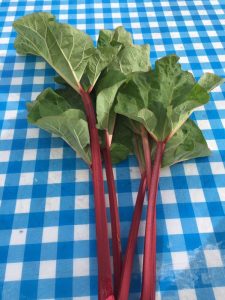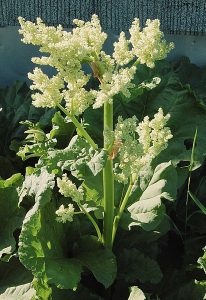Growing rhubarb
Rhubarb thrives across Canada from the Atlantic to the Pacific, and maybe even the Far North (rhubarb is said to grow wild in Alaska, so why not Yukon?). It needs a few weeks of cold weather to force its growth (below 4 degrees Celsius) and extra mulching in lengthy cold winters. Otherwise, mild to moderate temperatures of 20- 25 degrees Celsius and a nitrogen-rich soil suit it very well. Abandoned homesteads across Canada attest to the longevity of culinary or domesticated rhubarb. If you look around an old house site, you may not see a building, but you”ll often see a rhubarb patch.
Rhubarb is a herbaceous perennial with short, thick rhizomes (underground roots), large fleshy edible petioles (stalks), and inedible leaves that may grow as big as 150 cm. across. It’s in the botanical family of Polygonaceae, the same as buckwheat and knotweed, and its genus is Rheum which means “flow’ referring to its use as a purge and laxative. The classification of plants and animals follows a defined system familiar to botanists and challenging for non-botanists like me (1).
Although the whole idea of varieties continues to be debated by authorities who say that rhubarb is too intermixed to determine cultivars, some gardeners are trying to restore heirloom or old cultivars of rhubarb (2). Culinary rhubarb can be divided into two colour groups: red stalks and green stalks are equally ripe regardless of their colour, and equally nutritious. Fans of red stalks (e.g. Canada Red or Colorado Red) claim it’s sweeter, but generally smaller and less hardy. Part of the British rhubarb mania around the coronation of Queen Victoria in 1837 led to the naming of Victoria rhubarb, green stalks with streaks of red. Westcoast Seed Catalogue lists three varieties for mail-order sale. The Rhubarb Compendium gives information on varieties, cultivars, and other facts about rhubarb.
Rhubarb can be propagated by buying crowns, saving rhubarb seed or by dividing the plants. When the showy, extravagant rhubarb flowers appear in the middle of the plant, some gardeners remove them and others don’t. Seeds from the rhubarb flowers don’t always come true to the parent plant, so a more sure way is to dig up some of the plant and divide it into “crowns” with two or three eyes or sprouts in each crown. Then, plant each crown where it has lots of room to grow, and proceed to neglect it. (You could provide a layer of mulch in the fall if your winter climate is very cold).
Gardeners are advised to harvest rhubarb sparingly the first couple of years in order for the roots to get well established, and to pull the stalks out rather than cutting them out. When the plant is well-established, no more than half should be harvested at a time.
Winter rhubarb, kept in absolute darkness in forcing sheds, produces sweeter rhubarb than the average garden variety although the process called “etiolation” seems onerous. In England, the Yorkshire Forced Rhubarb Triangle (Bradford-Leeds- Wakefield) is famous for its forcing sheds.
Rhubarb is hard to kill. When I lived in Quesnel, I heard a story about someone who decided to run the lawnmower through the rhubarb patch in order to eradicate it. The next year, there was rhubarb everywhere in the rhubarb-hater’s yard.
Planting heritage or heirloom rhubarb could be a wonderful way of making sure that you always have a piece of history available in the form of (what else) rhubarb pie. There will be more information and ideas in the next blog about various ways to use and enjoy the “pie plant.” And also, rhubarb festivals and celebrations around the world.
References:
(1) Plant classifications defeat many non-botanists, including me. Maybe the following mnemonic device will help: kingdom, phylum, class, order, family, genus, species: “King Philip came over for good soup”.
(2) The Rhubarb Compendium: More than you ever wanted to know about rhubarb describes rhubarb varieties (based on the colour of the stalks) as red or green(which has streaks of red). The top red variety in Canada according to the website is MacDonald, and the top green is Victoria. Many heirloom rhubarbs are probably one or the other.



